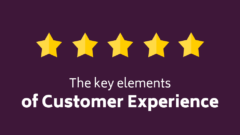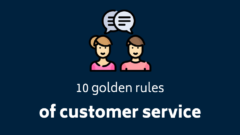Is your store visible in Google search results? Is it on the first page? If it’s not there yet, make sure to use these SEO in eCommerce hacks!
Visibility of your store on the first page of organic search results is critical nowadays. Moreover, SEO in eCommerce has always been important and will always be. Since almost every online shopper looks up their desired products in Google, Yahoo or Bing first, it’s a perfect opportunity to grab their attention, and in the end – make them buy from you instead of competition. To use the full potential of popular search engines, take some time to introduce SEO-friendly techniques and content to your website.
What’s SEO in eCommerce for?
Search Engine Optimisation is a way of making your store rank higher in Google, Bing, Yahoo and other popular search engines. It helps you gain credibility and recognition without any financial costs. The ideal case scenario is when your organic search results drive enough traffic to your page, that you can ditch paid advertising altogether – but to achieve this goal, you need to be consistent in your SEO efforts from the day one.
SEO in eCommerce is an ongoing endeavour, and the sooner you start, the better. In fact, you should plan your SEO strategy before setting up a webpage for your store. That way you can introduce some of the SEO techniques already during the development stage, and save lots of time later.
Impressive SEO in eCommerce techniques
 There’s no doubt that Google is the biggest search engine out there. If you rank high in Google, then other search engines will recognise the relevance of your website as well. Optimise your store accordingly to the three main algorithm updates that Google uses to evaluate sites: Panda, Penguin and Hummingbird.
There’s no doubt that Google is the biggest search engine out there. If you rank high in Google, then other search engines will recognise the relevance of your website as well. Optimise your store accordingly to the three main algorithm updates that Google uses to evaluate sites: Panda, Penguin and Hummingbird.
Note, that no one knows for sure how Google algorithm really works – Google drops hints about it, but the details were never revealed. For many years SEO specialists around the globe tried to figure it out by trial and error, and by now they have a pretty good idea what helps pages rank higher. Still, algorithms constantly evolve so there’s no guarantee that what works today will work tomorrow.
Panda
Panda is an on-site quality guard. This algorithm is very useful for SEO in eCommerce and was launched in 2011 to ensure that the most valuable websites rank on top of the result page, and the low-quality ones dropped down to the very end. Panda hardly ever affects only one page or landing, because it evaluates the website as a whole.
What Panda likes:
- Quality over quantity
- Original content
- Good formatting
- Helpful content
- Fresh content
What Panda hates:
- Duplicate content
- Keyword stuffing
- Thin content
- Content farms
Warning!
Many eCommerce websites were punished by Panda for unwillingly violating its strict “no duplicate content” rule. How did this happen? E.g. If they sold one T-shirt in 5 different colours then product pages for each colour were almost identical. Imagine the number of pages “duplicated” in such a way in a store that offers 500 products!
To keep your online store from getting demoted by Panda, use canonical tags. The canonical tag is a way of telling Google which one of the similar pages is the most important and should be displayed in search results. To learn all the methods of defining a canonical page, read these guidelines published by Google Support.
Panda is definitely one of the top three systems affecting SEO in eCommerce.
Penguin
 Penguin’s main focus are links that lead to your website. Before this algorithm update came out, the practice of buying links allowed spammers to climb too high in search results. Now, that the Penguin’s here, quality of the links is much more important than quantity. SEO in eCmmerce is now much more organic and it’s much harder to cheat in this field.
Penguin’s main focus are links that lead to your website. Before this algorithm update came out, the practice of buying links allowed spammers to climb too high in search results. Now, that the Penguin’s here, quality of the links is much more important than quantity. SEO in eCmmerce is now much more organic and it’s much harder to cheat in this field.
While you decide what links are displayed on your website, you have little control over the links that lead to your website. If they come from a place considered untrustworthy and irrelevant, you will be punished. So what should you do?
Monitor where the traffic to your website comes from and use the Google Disavow Tool if you see any suspicious source.
Hummingbird
This algorithm change altered the way that Google perceives helpfulness of your content in correlation with what people are searching for. In other words, Google tries to guess the intent and context of search phrases to match them with the most relevant results possible.
The release of Hummingbird didn’t shake the status quo as much as Panda and Penguin did. Most websites didn’t experience any negative impact. In fact, in case of issues of SEO in eCommerce, you should perceive Hummingbird as an opportunity rather than another obstacle to overcome.
Hummingbird has the power of highlighting helpful content and driving more traffic to your page than ever before. If you want to impress the Hummingbird with some SEO in eCommerce hacks, you need to think beyond keywords and create content that is written by humans for humans in a natural, conversational language. Keep that in mind whenever you post something on your website.
On-page SEO
 As an eCommerce manager, you should think about your On-page SEO early on, before building your website. The best thing about on-page SEO in eCommerce is that you’re in full control of it, so it’s easy to plan ahead and develop a good strategy.
As an eCommerce manager, you should think about your On-page SEO early on, before building your website. The best thing about on-page SEO in eCommerce is that you’re in full control of it, so it’s easy to plan ahead and develop a good strategy.
First, do the proper keyword research. Try to think like your potential client – what phrase would you be most likely to search if you wanted to find a store or a product? Write those phrases down so you can use them for web pages, content creation and marketing. SEO in eCommerce is all about predicting your customers’ moves!
There are online tools that can help you find relevant keywords, e. g. Google Keyword Planner.
High Search Volume and Low Competition are the most important factors when looking for keywords. You need to find terms that are frequently used in searches but are not too obvious to other marketers in your niche.
Now you know the keywords you’d like to rank high for in search results, it’s time to put them in all the texts, image tags, heading tags, meta titles, and meta descriptions on your website. To get the best results, do it consistently as you create content because filling the gaps after some time is one of those meticulous tasks you’d rather avoid. Withouc consistency, SEO in eCommerce never works. Don’t forget about it.
As Google algorithm also pays attention to the structure of your website, take time to find a responsive website template that displays well on all kinds of devices. Also, choose a reliable hosting with unlimited bandwidth that will serve up your site quickly. Keep your website always at its best performance.
Off-page SEO
Off-page SEO is a way of building the authority of your website by creating a network of links that lead back to it. The more links from quality sources are driving traffic to your website, the more relevant your page is in Google’s eyes.
How to build your link network?
- Get a blog that provides quality content related to your business and frequently links to your main website.
- Step up your social media game. Viral branded posts can do wonders to your search engine ranking.
- Consider investing in press releases and sponsored articles on websites that are influential in your field.
- Be active on specialistic forums and leave links to your website there as often as possible (if it doesn’t violate forum’s rules).
Using all of the above techniques is permitted, even recommended, by Google. Your “white hat” SEO efforts help people find what they look for – and it’s good both for your business and for Google. But it’s sometimes tempting to use shortcuts to lift page’s ranking without providing additional value – they’re called “black hat” SEO techniques. Here’s what they are and why you should avoid them:
Black hat SEO
Black hat SEO is optimisation aimed to outwit algorithms with practices that go against search engine guidelines.
Examples of “black hat” SEO:
- Keyword stuffing – Excessive use of keywords without providing valuable content.
- Hidden text – Tricking Google into thinking, that your page offers something it doesn’t by making parts of content invisible to the user.
- Unnatural linking – Investing in link farms is a waste of money. Only credible sources help you rank higher in search results.
- Plagiarism – copying content to your site from other places on the internet is not only unethical but also illegal.
- Parked domains – reserved URLs without any content won’t show up on the first SERP.
- Meta descriptions for robots – Meta tags and descriptions are clues for Google to figure out what your website is about, but they should be written in a sentence so the average user can read them too.
Panda, Penguin and Hummingbird are patrolling the web to identify and punish spammy websites so using any of those outdated shortcuts will bring you more losses than gains. Plus, it wouldn’t help you get consumer’s trust either, so why bother? Honest SEO takes more time but is much more beneficial in the long run.
In conclusion
There are four main takeaways from this article. To keep your website SEO-friendly, do the following:
- Always bet on quality over quantity – both with content and links.
- Write for humans, not for search engines.
- Build a good linking network with websites similar to yours.
- Take social media sharing and branded social mentions seriously – they’re bound to matter more and more for search engine algorithms in the future.
About the author

- Elliot
- Content specialist and gaming enthusiast. Trained to be a philosopher. Interested in Deep Learning, scalability and startups.






